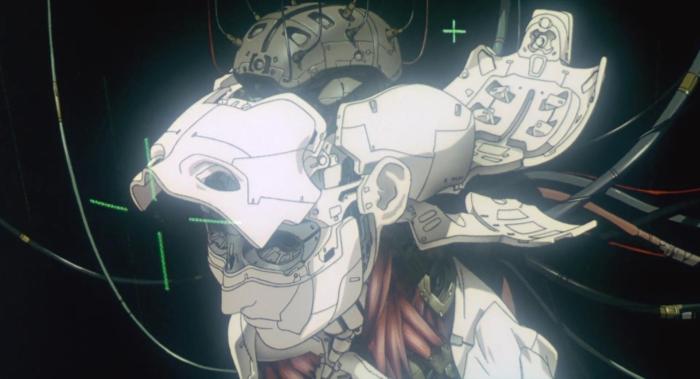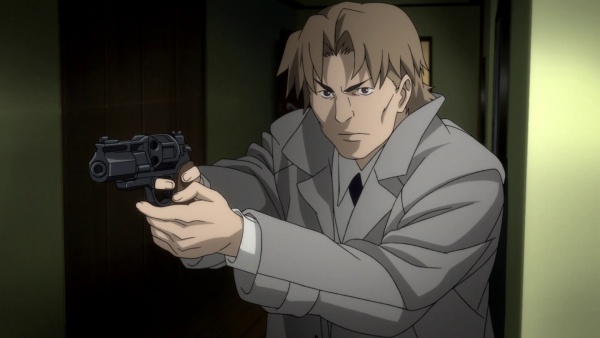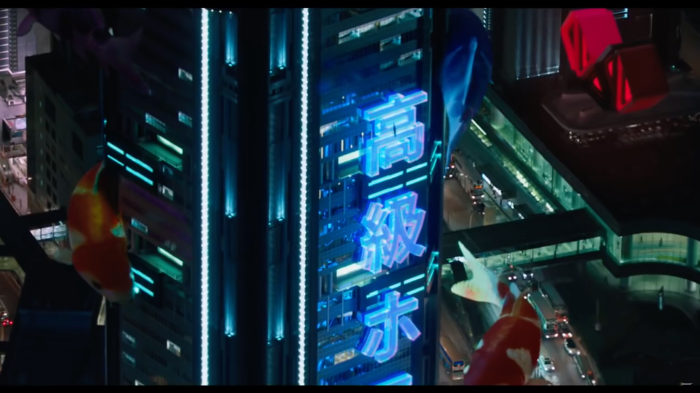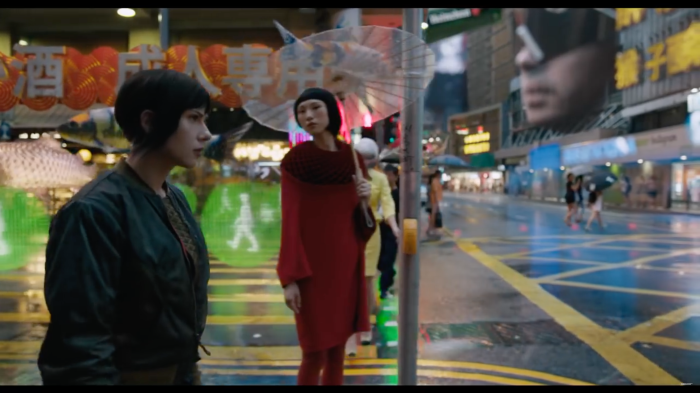
Portions of this text were originally written on typewriter and converted to electronic text, while other parts were originally electronic and then re-typed. There’s original typed and electronic sections as well.
This is the trailer for the modern re-making of the Anime film.


There’s a powerful sequence at the start of both the new and old film where ‘The Major’ is ‘born’
The Major is the lead protagonist in a team that investigates cyber-crime and acts on the behalf of the public. The team is known as Public Security Section 9.
The film is currently being re-made by an American studio with a big budget, and is set for release next March. The original is considered a classic, and while it is a science-fiction action film, the director made it deliberately slow-paced to allow audiences the time to appreciate the artistry, and contemplate the complex philosophical questions posed. Roger Ebert himself described it as “too complex and murky to reach a large audience”, and stressed that the film is “not in any sense an animated film for children”.
So it will be interesting to see what the American studio makes of the film. That said, I’m hugely excited, as from an aesthetic standpoint, the world that Ghost In The Shell is set in, is incredible, and I’m eager to see what they make of the film using modern technology – even if they are aiming for a PG-13 (more child friendly, right Roger?) rating.
The plot of the original Anime film is actually rather thin, and is structured more to allow for complex discussion on the themes, rather than involving the audience through the story. It centres a hunt for a character named ‘The Puppet Master’ – a hacker that has been invading and controlling both cybernetic and biological humans alike.
The old grinding against the new is a major theme in this film


The future depicted in this film is neither dystopia or utopia. But rather a conglomerate of real-world environments. Set in Japan, the fictional city that the characters move around is clearly inspired by Hong Kong. The 2017 update borrows heavily from this, and is richly Japanese, while cramming the populace into a city that nods sometimes at Kowloon Walled City.
In the middle of the original 1995 film there’s a 3 or so minute sequence that doesn’t advance the plot and contains no dialogue, but is a rich depiction of the fictional city. It is also a silent but deep discussion about the central character, who struggles to understand if she is human – and is her human brain enough to make her so, or is she just an artificial creation. As she travels through the city, she is confronted by other copies of her artificial body living their daily life, while she looks at a city filled with discarded man-made products, wondering if that is her fate.
Technology ‘breeds in weakness’
The city scene is also an expression of our modern space and life, as natural and non-natural humans push themselves up and down roads and paths like electrons on a circuit board, showing how humans have only an illusion of freedom in their own space.
This sequence is often disregarded as ‘the intermission’ sequence, however it is quite possibly one of the most important parts of the film. Have a watch if you have a few minute:-
This sequence is unlikely to be re-created in the new version of the film. However, there’s already plenty of evidence that the film will still undertake the same character exploration. The trailer demonstrates a strong understanding of the central character’s struggle to understand her identity. If you look closely, there’s a fish motif that is present – a hint to the characters struggles. The original film featured the central character diving in the ocean, floating and feeling more human for it, while it replicated the moments of her birth. The Anime’s city scene also features planes that drift over the city gently like whales that have become birds. A complex identity and transformation.


The latter photo appears to be taken from a scene that seems just as exploratory of the city and the character’s identity as the original film’s city scene.


The original film doesn’t dismiss ‘natural’ as being obsolete however. Togusa finds himself as part of the team, as his humanity allows for thinking outside of the homogenised box created by the puritanicalism of technology. For all the faults that humans have that technology can rectify, non-technology elements are needed to ensure that technology doesn’t become limiting. Technology creates unlimited freedom, but limits it if you remain only on the path of that technology. Or as the film puts it ‘It breeds in weakness’
Underlying this is a complex set of values that the characters hold. While in the original film the Major doesn’t present as a sexual entity – herself uninterested in what her often near nudity presents, other characters offset this. Batou – the Major’s workmate and closest friend can be seen at one point covering her nudity up. Her relationship with Batou also explores other aspects of The Major’s sexuality, as she does not have an interest in becoming sexually involved.
That said, later television series produced by the same studio presents The Major as Bi-sexual, but often needing to force herself to produce intimacy. Demonstrating her struggle to even regard herself as a gender in an artificial body that cannot reproduce offspring.
*Whitewashing Cinema
It is important to note that there’s considerable controversy around the new film. ‘The Major’ in the American version is being played by white, American woman – Scarlet Johansson. This has – and reasonably rightly so, upset some commentators in the USA, who believe that replacing an asian character with an caucasian is cultural white-washing.
The reason is no doubt commercial. The actor choice is more about getting a target American audience to relate to the character, and ensure greater success of the film. They chose a name actor with commercial bankability.
Is it wrong? It is hard to say. People scoff at a white woman having an Asian name, but I can’t help but think of my nephew who has a Japanese name, and is white anglo Australian. The creators of the original film and manga series also seem to have no problems with this, as they themselves expected the film to have an American as the central character.
But at the same time, I can’t help but feel sad that American audiences aren’t given the opportunity to have Asian faces on screen. That said, I’m glad to see that the film hasn’t transplanted the story to – say, New York. Something which I have often found dreadful about American screen art. Ever seen Godzilla (1998), or watched the TV series ‘Elementary’ – to name a few, where stories are transplanted to NY just…. because. And subsequently become just another bland ‘New York Story’.
At the same time, the original film borrows heavily from William Gibson’s stories – which are largely set in America, with American-ised characters. Much of which is adapted to be much more Japanese.
Personally, I think the direction in the new film is good. If people need an Asian face, the white-washing hasn’t become so complete that they can’t go and find a copy of the original out there and watch that still. Sure, it would have been great to see an Asian face on an American production, but there’s plenty in the film as it is. I like the idea of using an American face to transport the audience into a distinctly Asian environment. I think it allows much more diversification by transporting the intended audience out of their comfort-zone.
And let’s be frank. The central character isn’t a race or a culture. It is a cyborg, and can look like anything. I think the fight being picked over this somewhat way over the top. But admittedly I am myself a white caucasian male.
I’ll see the film, and I’m eager to see it.
Thanks for the heads-up. As much as I like Scarlet Johansson, why couldn’t they cast a Japanese actress???? Sonoya Mizuno who stole the show (for me) in Ex Machina would have been perfect!
LikeLike
I think the reason was simple. “Should we use a white American woman”?
“¥€$”!
LikeLiked by 1 person
Thanks, I was not aware of the original film or this remake.
Unfortunately, the 3-minute sequence won’t play on US YouTube due to copyright restrictions.
LikeLike